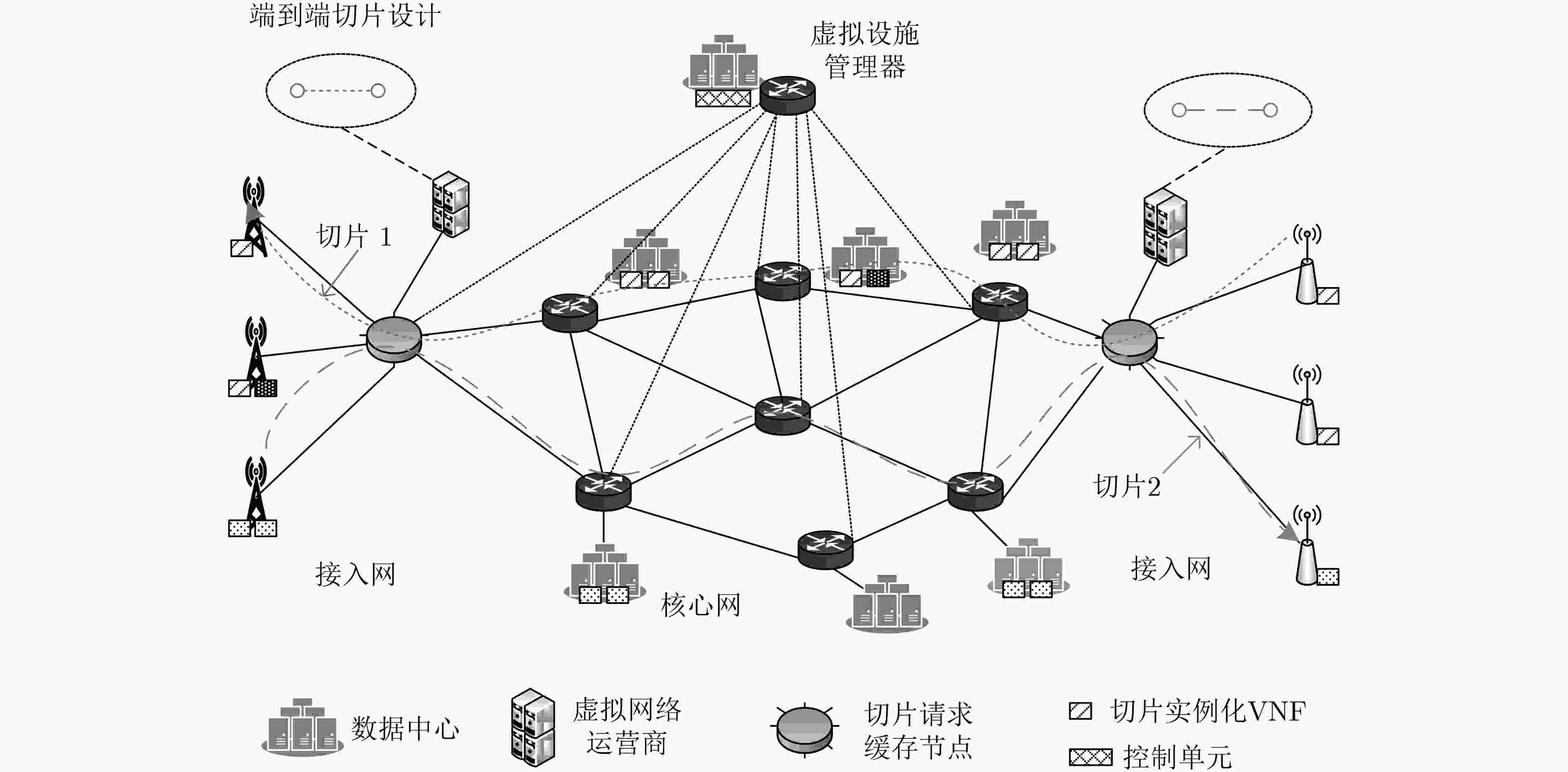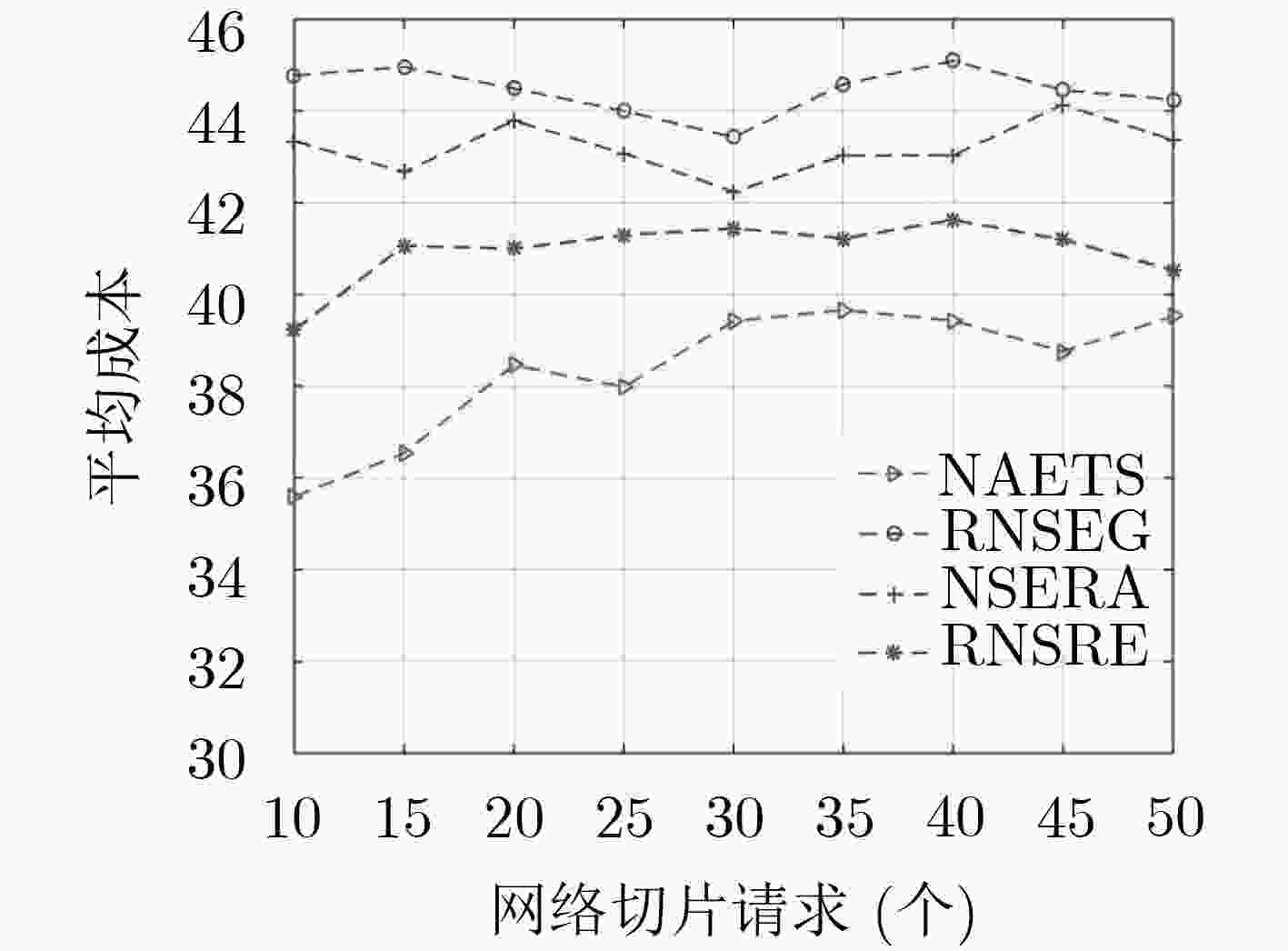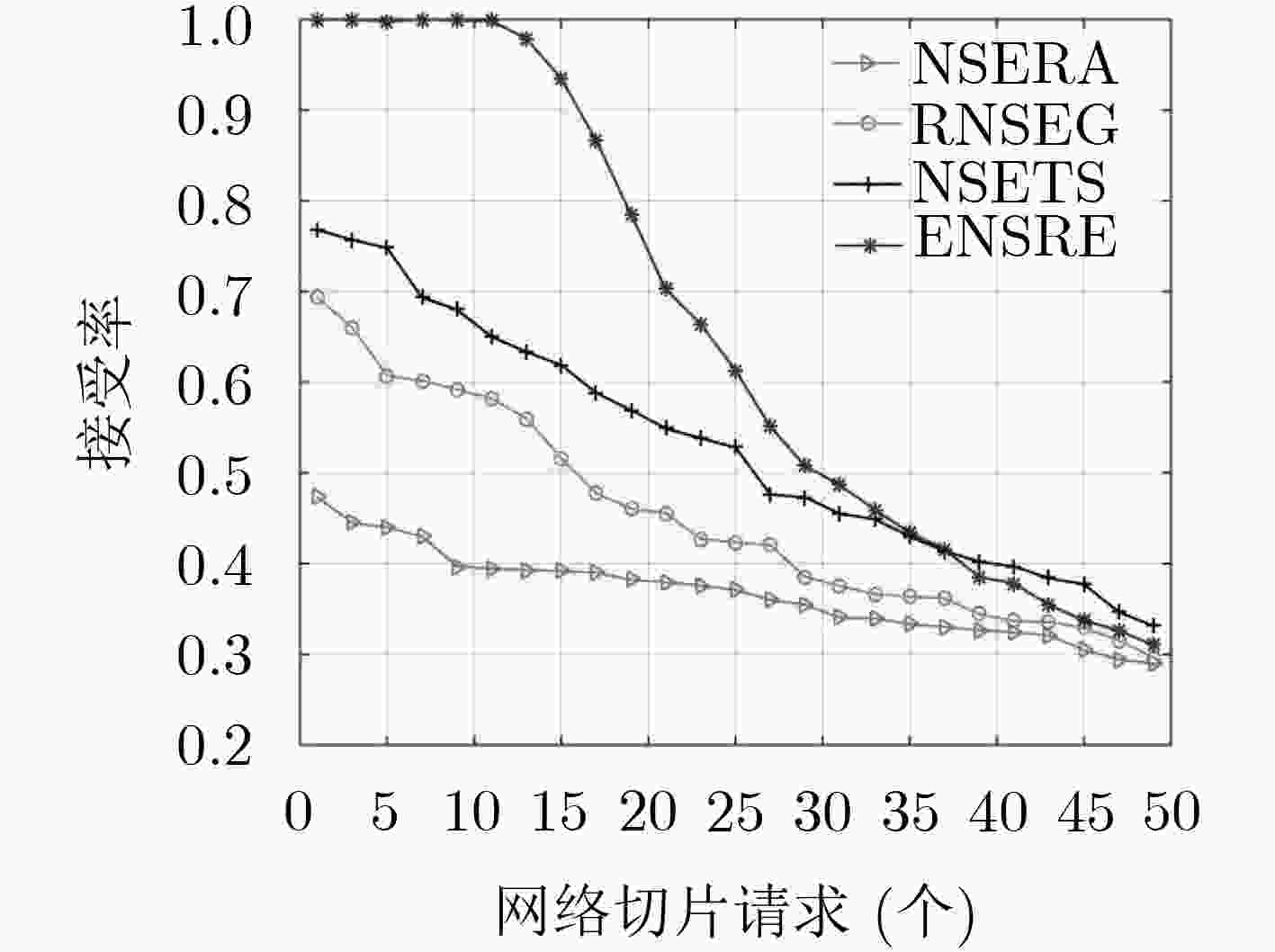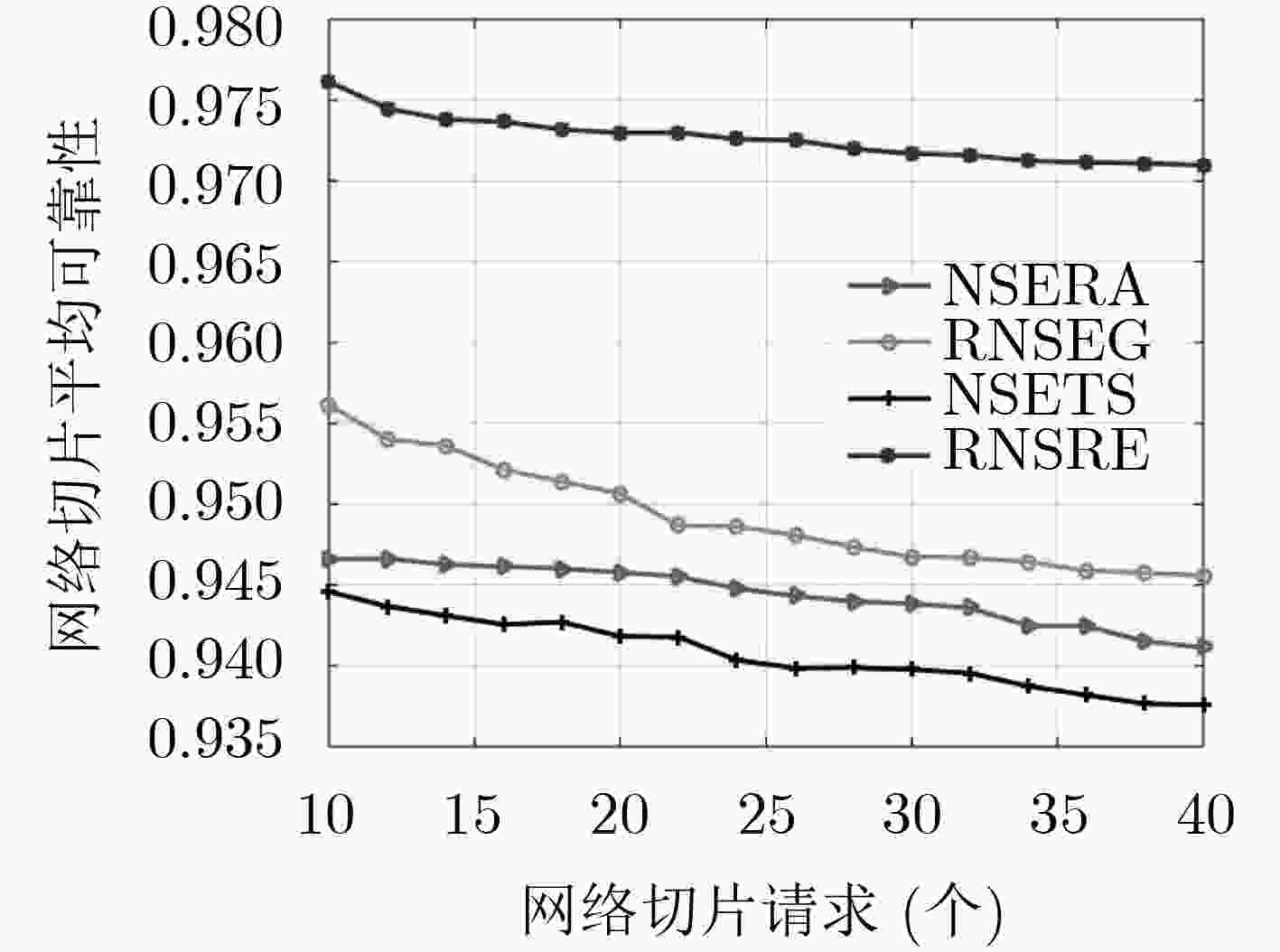A Reliability-aware 5G Network Slice Reconfiguration and Embedding Algorithm
-
摘要:
针对传统网络切片映射方法资源利用率低且可靠性差的问题,该文提出了可靠性感知的网络切片(NS)重构及映射策略(RNSRE)。首先,建立了面向可靠性和资源的网络切片可靠映射效用函数。其次,综合考虑虚拟网络功能(VNF)的资源需求和位置约束,提出了一种VNF可靠性需求的度量方法。在此基础上,以最大化VNF可靠部署收益的同时最小化链路带宽资源开销为目标,建立了切片可靠映射整数线性规划模型。最后,针对不同的网络切片类型,提出了基于邻域搜索的网络切片映射算法和关键VNF备份的网络切片重构映射算法。仿真结果表明,所提算法在满足VNF可靠性需求的同时,提高了资源利用率,降低了映射的开销。
Abstract:Considering the problems of low resource utilization and poor reliability of traditional network slice embedding, a Reliability-aware Network Slice (NS) Reconfiguration and Embedding (RNSRE) strategy is proposed. Firstly, a utility function of reliable embedding oriented reliability and available resources is established. Then, considering the resource requirements and the location constraints of Virtual Network Function (VNF), a method is proposed to quantify the reliability requirement of VNF. Based on the above works, the reliable network slice embedding problem is formulated as an integer linear programming which maximizes the profits of reliable VNF deployment while minimizing the consumption of link bandwidth resource. Finally, according to different types of network slices, a network slice reliable embedding algorithm based on neighborhood search and a network slice reconfiguration embedding algorithm based on key VNF backup are proposed. Simulation results show that the proposed algorithms improve the resources utilization and reduce the embedding cost while meeting the reliability of VNF.
-
Key words:
- 5G Network Slice (NS) /
- Reliable embedding /
- Resource utilization
-
表 1 基于邻域搜索的网络切片映射算法
输入:NSR $G_v^{\rm{g}} = (V_{\rm{g}},E_{\rm{g}},R_{{\rm{req}}}^{\rm{g}})$,物理网络${G_{\rm{s}}} = \left( {{N_{\rm{s}}},{L_{\rm{s}}}} \right)$ (5) ${P_i} = P_{{\rm{next}}}^{\rm{g}}$, ${R_{{\rm{gap}}}} = \displaystyle\prod\limits_{{n_i} \in P_{{\rm{next}}}^{\rm{g}}} {{R_i}} - R_{{\rm{req}}}^{\rm{g}}$ 输出:NSE方案${P^{\rm{g}}} = \left[ {P^{\rm{g}}\left( {{v_k}} \right),P^{\rm{g}}\left( {{e_k}} \right)} \right]$ (6) 计算当前的带宽消耗为${b_{\rm{g}}}$ (1) 搜索空间$S$, $P_{{\rm{opt}}}^{\rm{g}} = {P_{{\rm{init}}}}$; ${P_i} = P_{{\rm{init}}}^{\rm{g}}$ (7) end if (2) while($0.5 \le { { {R_{ {\rm{gap} } } }} / { {R_{ {\rm{req} } } } } } + { {\left( { {b^{\rm{g} } } - b_{ {\rm{req} } }^{\rm{g} } } \right)} / {b_{ {\rm{req} } }^{\rm{g} } } } \le 1$), do (8) if $\left( {{\rm Obj}\left( {P_{ {\rm{next} } }^{\rm{g} } } \right) < {\rm Obj}\left( {P_{ {\rm{opt} } }^{\rm{g} } } \right)} \right)$ then (3) 在${P_i}$的邻域解中搜索当前更优的个体$P_{{\rm{next}}}^{\rm{g}}$ (9) $P_{{\rm{opt}}}^{\rm{g}} = P_{{\rm{next}}}^{\rm{g}}$ (4) if $\displaystyle\prod\limits_{ {n_i} \in P_{ {\rm{next} } }^{\rm{g} } } { {R_i} } \ge R_{ {\rm{req} } }^{\rm{g} }$ then (10) end if (11) end while 表 2 关键VNF备份网络切片重构算法
输入:NSR $G_v^{\rm{g}} = (V_{\rm{g}},E_{\rm{g}})$,备份节点集${V_{{\rm{reconf}}}}$
输出:${P^{\rm{g}}} = \left[ {P_{}^{\rm{g}}\left( {{v_k}} \right),P_{}^{\rm{g}}\left( {{e_k}} \right)} \right]$
(1) for each $v_i^{\rm{g}} \in {V_{{\rm{reconf}}}}$
(2) 专有备份节点$v_i^b$, $C_k^b = C_i^{\rm{g}}$,
(3) 备份链路
(4) 基于式(23)得到$R\left( {G_{{\rm{backup}}}^{\rm{g}}} \right)$
(5) end for
(6) while($R\left( {G_{ {\rm{backup} } }^{\rm{g} } } \right) \le R_{ {\rm{req} } }^{\rm{g} }$), do
(7) for all $v_k^{\rm{g}} \in {V_{\rm{g}}}$, do
(8) 按照VNF可靠性递增,对节点进行排序(9) 选择相邻VNF对提供共享备份节点$v_i^b$, $C_k^b = \max \left\{ {C_i^{\rm g} ,C_j^{\rm{g}}} \right\}$
(10) 选择关键VNF对$v_i^{\rm{g}},v_j^{\rm{g}} = {\rm{arg}}\;{\rm{max}}\left\{ {{\theta _{ij}}|v_i^{\rm{g}},v_j^{\rm{g}} \in {V_{\rm{g}}}} \right\}$
(11) 根据$v_i^{\rm{g}},v_j^{\rm{g}} \in {V_{\rm{g}}}$的状态,选择共享备份可靠性估算模型得到
$R\left( {G_{{\rm{backup}}}^{\rm{g}}} \right)$
(12) end for
(13) 链路备份
(14) end while
(15) return表 3 仿真参数设置表
仿真参数 参数设置 仿真参数 参数设置 物理节点的数目 N=12, 25, 36 物理节点CPU资源容量 U[10, 20] 物理节点可靠性分布 U[0.95, 0.99] 物理链路带宽资源容量 U[20, 50] NSR的VNF个数 3 NSR生命周期 [4, 12, 24] 3种类型切片的可靠性需求 U[0.90, 0.98] VNF节点CPU资源需求 U[2, 6] VNF之间带宽资源需求 U[8, 16] -
ZHANG Haijun, LIU Na, CHU Xiaoli, et al. Network slicing based 5G and future mobile networks: Mobility, resource management, and challenges[J]. IEEE Communications Magazine, 2017, 55(8): 138–145. doi: 10.1109/MCOM.2017.1600940 ORDONEZ-LUCENA J, AMEIGEIRAS P, LOPEZ D, et al. Network slicing for 5G with SDN/NFV: Concepts, architectures, and challenges[J]. IEEE Communications Magazine, 2017, 55(5): 80–87. doi: 10.1109/MCOM.2017.1600935 FOUKAS X, PATOUNAS G, ELMOKASHFI A, et al. Network slicing in 5G: Survey and challenges[J]. IEEE Communications Magazine, 2017, 55(5): 94–100. doi: 10.1109/MCOM.2017.1600951 LI Xi, CASELLAS R, LANDI G, et al. 5G-crosshaul network slicing: Enabling multi-tenancy in mobile transport networks[J]. IEEE Communications Magazine, 2017, 55(8): 128–137. doi: 10.1109/MCOM.2017.1600921 VASSILARAS S, GKATZIKIS L, LIAKOPOULOS N, et al. The algorithmic aspects of network slicing[J]. IEEE Communications Magazine, 2017, 55(8): 112–119. doi: 10.1109/MCOM.2017.1600939 ZHANG Nan, LIU Yafeng, FARMANBAR H, et al. Network slicing for service-oriented networks under resource constraints[J]. IEEE Journal on Selected Areas in Communications, 2017, 35(11): 2512–2521. doi: 10.1109/JSAC.2017.2760147 GUAN Wanqing, WEN Xiangming, WANG Luhan, et al. A service-oriented deployment policy of end-to-end network slicing based on complex network theory[J]. IEEE Access, 2018, 6: 19691–19701. doi: 10.1109/ACCESS.2018.2822398 刘光远, 苏森. 面向底层单节点失效的轻量级可靠虚拟网络映射算法[J]. 电子与信息学报, 2013, 35(11): 2644–2649. doi: 10.3724/SP.J.1146.2013.00254LIU Guangyuan and SU Sen. Less stringent reliable virtual network mapping algorithm for substrate single node failure[J]. Journal of Electronics &Information Technology, 2013, 35(11): 2644–2649. doi: 10.3724/SP.J.1146.2013.00254 LIU Jiajia, JIANG Zhongyuan, KATO N, et al. Reliability evaluation for NFV deployment of future mobile broadband networks[J]. IEEE Wireless Communications, 2016, 23(3): 90–96. doi: 10.1109/MWC.2016.749807 KONG Jian, KIM I, WANG Xi, et al. Guaranteed-availability network function virtualization with network protection and VNF replication[C]. 2017 IEEE Global Communications Conference, Singapore, 2017: 1–6. doi: 10.1109/GLOCOM.2017.8254730. CHEN Yiheng, AYOUBI S, and ASSI C. CORNER: COst-efficient and reliability-aware virtual NEtwork redesign and embedding[C]. The 3rd IEEE International Conference on Cloud Networking, Luxembourg, 2014: 356–361. doi: 10.1109/CloudNet.2014.6969021. SUN Jian, ZHU Guangyang, SUN Gang, et al. A reliability-aware approach for resource efficient virtual network function deployment[J]. IEEE Access, 2018, 6: 18238–18250. doi: 10.1109/ACCESS.2018.2815614 BIJWE S, MACHIDA F, ISHIDA S, et al. End-to-end reliability assurance of service chain embedding for network function virtualization[C]. 2017 IEEE Conference on Network Function Virtualization and Software Defined Networks (NFV-SDN), Berlin, Germany, 2017: 1–4. doi: 10.1109/NFV-SDN.2017.8169853. QU L, ASSI C, SHABAN K, et al. A reliability-aware network service chain provisioning with delay guarantees in NFV-enabled enterprise datacenter networks[J]. IEEE Transactions on Network and Service Management, 2017, 14(3): 554–568. doi: 10.1109/TNSM.2017.2723090 CATELANI M, CIANI L, PATRIZI G, et al. Reliability allocation procedures in complex redundant systems[J]. IEEE Systems Journal, 2018, 12(2): 1182–1192. doi: 10.1109/JSYST.2017.2651161 FAN Jingyuan, YE Zilong, GUAN Chaowen, et al. GREP: Guaranteeing reliability with enhanced protection in NFV[C]. 2015 ACM SIGCOMM Workshop on Hot Topics in Middleboxes and Network Function Virtualization, London, UK, 2015: 13–18. MIZIULA P and NAVARRO J. Birnbaum importance measure for reliability systems with dependent components[J]. IEEE Transactions on Reliability, 2019, 68(2): 439–450. doi: 10.1109/TR.2019.2895400 -






 下载:
下载:






 下载:
下载:
